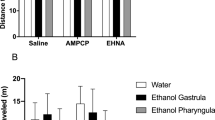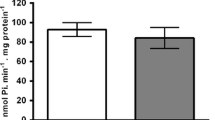Abstract
Adenosinergic signaling has important effects on brain function, anatomy, and physiology in both late and early stages of development. Exposure to caffeine, a non-specific blocker of adenosine receptor, has been indicated as a developmental risk factor. Disruption of adenosinergic signaling during early stages of development can change the normal neural network formation and possibly lead to an increase in susceptibility to seizures. In this work, morpholinos (MO) temporarily blocked the translation of adenosine receptor transcripts, adora1, adora2aa, and adora2ab, during the embryonic phase of zebrafish. It was observed that the block of adora2aa and adora2aa + adora2ab transcripts increased the mortality rate and caused high rate of malformations. To test the susceptibility of MO adora1, MO adora2aa, MO adora2ab, and MO adora2aa + adora2ab animals to seizure, pentylenetetrazole (10 mM) was used as a convulsant agent in larval and adult stages of zebrafish development. Although no MO promoted significant differences in latency time to reach the seizures stages in 7-day-old larvae, during the adult stage, all MO animals showed a decrease in the latency time to reach stages III, IV, and V of seizure. These results indicated that transient interventions in the adenosinergic signaling through high affinity adenosine receptors during embryonic development promote strong outcomes on survival and morphology. Additionally, long-term effects on neural development can lead to permanent impairment on neural signaling resulting in increased susceptibility to seizure.









Similar content being viewed by others
References
Wendler CC, Busovsky-McNeal M, Ghatpande S, Kalinowski A, Russell KS, Rivkees SA (2009) Embryonic caffeine exposure induces adverse effects in adulthood. FASEB J 23(4):1272–1278. https://doi.org/10.1096/fj.08-124941
Buscariollo DL, Breuer GA, Wendler CC, Rivkees SA (2011) Caffeine acts via A1 adenosine receptors to disrupt embryonic cardiac function. PLoS One 6(12):e28296. https://doi.org/10.1371/journal.pone.0028296
Stefanidou EM, Caramellino L, Patriarca A, Menato G (2011) Maternal caffeine consumption and sine causa recurrent miscarriage. Eur J Obstet Gynecol Reprod Biol 158(2):220–224. https://doi.org/10.1016/j.ejogrb.2011.04.024
Adén U, Leverin a L, Hagberg H, Fredholm BB (2001) Adenosine a(1) receptor agonism in the immature rat brain and heart. Eur J Pharmacol 426(3):185–192. https://doi.org/10.1016/S0014-2999(01)01220-1
Fredholm BB (1995) Adenosine, adenosine receptors and the actions of caffeine. Pharmacol Toxicol 76(2):93–101. https://doi.org/10.1111/j.1600-0773.1995.tb00111.x
Rhee J, Kim R, Kim Y, Tam M, Lai Y, Keum NN, Oldenburg CE (2015) Maternal caffeine consumption during pregnancy and risk of low birth weight: A dose-response meta-analysis of observational studies. PLoS One 10(7):e0132334. https://doi.org/10.1371/journal.pone.0132334
Ross CP, Persaud TV (1986) Cardiovascular primordium of the rat embryo following in utero exposure to alcohol and caffeine. Can. J, Cardiol
Christian MS, Brent RL (2001) Teratogen update: evaluation of the reproductive and developmental risks of caffeine. Teratology 64(1):51–78. https://doi.org/10.1002/tera.1047
Massé K, Dale N (2012) Purines as potential morphogens during embryonic development. Purinergic Signal 8(3):503–521. https://doi.org/10.1007/s11302-012-9290-y
Tchekalarova JD, Kubová H, Mareš P (2014) Early caffeine exposure: transient and long-term consequences on brain excitability. Brain Res Bull 104:27–35. https://doi.org/10.1016/j.brainresbull.2014.04.001
Guillet R, Dunham L (1995) Neonatal caffeine exposure and seizure susceptibility in adult rats. Epilepsia 36(8):743–749. https://doi.org/10.1111/j.1528-1157.1995.tb01610.x
Rivkees SA, Wendler CC (2012) Regulation of cardiovascular development by adenosine and adenosine-mediated embryo protection. Arterioscler Thromb Vasc Biol 32(4):851–855. https://doi.org/10.1161/ATVBAHA.111.226811
Dixon AK, Gubitz A, Sirinathsinghji DJ et al (1996) Tissue distribution of adenosine receptor mRNAs in the rat. Br J Pharmacol 118:1461–1468
Ilie A, Raimondo JV, Akerman CJ (2012) Adenosine release during seizures attenuates GABAA receptor-mediated depolarization. J Neurosci 32(15):5321–5332. https://doi.org/10.1523/JNEUROSCI.5412-11.2012
Montesinos MC, Shaw JP, Yee H, Shamamian P, Cronstein BN (2004) Adenosine a(2A) receptor activation promotes wound neovascularization by stimulating angiogenesis and vasculogenesis. Am J Pathol 164(6):1887–1892. https://doi.org/10.1016/S0002-9440(10)63749-2
Zimmermann H (2006) Nucleotide signaling in nervous system development. Pflugers Arch 452(5):573–588. https://doi.org/10.1007/s00424-006-0067-4
Wall M, Dale N (2008) Activity-dependent release of adenosine: a critical re-evaluation of mechanism. Curr Neuropharmacol 6(4):329–337. https://doi.org/10.2174/157015908787386087
Nagai K, Nagasawa K, Fujimoto S (2005) Transport mechanisms for adenosine and uridine in primary-cultured rat cortical neurons and astrocytes. Biochem Biophys Res Commun 334(4):1343–1350. https://doi.org/10.1016/j.bbrc.2005.07.032
Collis MG, Hourani SM (1993) Adenosine receptor subtypes. Trends Pharmacol, Sci
Fredholm BB, Chen J-F, Cunha RA et al (2005) Adenosine and brain function. Int Rev Neurobiol 63:191–270. https://doi.org/10.1016/S0074-7742(05)63007-3
Westerfield M (2007) The zebrafish book. A guide for the laboratory use of zebrafish (Danio Rerio), 5th Edition. Univ. Oregon Press. Eugene
Bill BR, Petzold AM, Clark KJ, Schimmenti l, Ekker SC (2009) A primer for morpholino use in zebrafish. Zebrafish 6(1):69–77. https://doi.org/10.1089/zeb.2008.0555
Kalueff AV, Gebhardt M, Stewart AM, Cachat JM, Brimmer M, Chawla JS, Craddock C, Kyzar EJ et al (2013) Towards a comprehensive catalog of zebrafish behavior 1.0 and beyond. Zebrafish 10(1):70–86. https://doi.org/10.1089/zeb.2012.0861
Riehl R, Kyzar E, Allain A, Green J, Hook M, Monnig L, Rhymes K, Roth A et al (2011) Behavioral and physiological effects of acute ketamine exposure in adult zebrafish. Neurotoxicol Teratol 33(6):658–667. https://doi.org/10.1016/j.ntt.2011.05.011
MacPhail RC, Brooks J, Hunter DL, Padnos B, Irons TD, Padilla S (2009) Locomotion in larval zebrafish: influence of time of day, lighting and ethanol. Neurotoxicology 30(1):52–58. https://doi.org/10.1016/j.neuro.2008.09.011
Baraban SC, Taylor MR, Castro PA, Baier H (2005) Pentylenetetrazole induced changes in zebrafish behavior, neural activity and c-fos expression. Neuroscience 131(3):759–768. https://doi.org/10.1016/j.neuroscience.2004.11.031
Mussulini BHM, Leite CE, Zenki KC, Moro L, Baggio S, Rico EP, Rosemberg DB, Dias RD et al (2013) Seizures induced by pentylenetetrazole in the adult zebrafish: a detailed behavioral characterization. PLoS One 8(1):e54515. https://doi.org/10.1371/journal.pone.0054515
Menezes FP, Da Silva RS (2017) The influence of temperature on adult zebrafish sensitivity to pentylenetetrazole. Epilepsy Res 135:14–18. https://doi.org/10.1016/j.eplepsyres.2017.05.009
Johansson B, Halldner L, Dunwiddie TV, Masino SA, Poelchen W, Gimenez-Llort L, Escorihuela RM, Fernandez-Teruel A et al (2001) Hyperalgesia, anxiety, and decreased hypoxic neuroprotection in mice lacking the adenosine A1 receptor. Proc Natl Acad Sci USA 98(16):9407–9412. https://doi.org/10.1073/pnas.161292398
Giménez-Llort L, Fernández-Teruel A, Escorihuela RM, Fredholm BB, Tobeña A, Pekny M, Johansson B (2002) Mice lacking the adenosine A1 receptor are anxious and aggressive, but are normal learners with reduced muscle strength and survival rate. Eur J Neurosci 16(3):547–550. https://doi.org/10.1046/j.1460-9568.2002.02122.x
Ledent C, Vaugeois JM, Schiffmann SN, Pedrazzini T, Yacoubi ME, Vanderhaeghen JJ, Costentin J, Heath JK et al (1997) Aggressiveness, hypoalgesia and high blood pressure in mice lacking the adenosine A2a receptor. Nature 388(6643):674–678. https://doi.org/10.1038/41771
Momoi N, Tinney JP, Liu LJ, Elshershari H, Hoffmann PJ, Ralphe JC, Keller BB, Tobita K (2008) Modest maternal caffeine exposure affects developing embryonic cardiovascular function and growth. Am J Physiol Heart Circ Physiol 294(5):H2248–H2256. https://doi.org/10.1152/ajpheart.91469.2007
Rivkees SA, Wendler CC (2017) Long-term consequences of disrupting adenosine signaling during embryonic development. Mol Asp Med 55:110–117. https://doi.org/10.1016/j.mam.2017.02.001
Boehmler W, Petko J, Woll M, Frey C, Thisse B, Thisse C, Canfield VA, Levenson R (2009) Identification of zebrafish A2 adenosine receptors and expression in developing embryos. Gene Expr Patterns 9(3):144–151. https://doi.org/10.1016/j.gep.2008.11.006
Chen YH, Huang YH, Wen CC, Wang YH, Chen WL, Chen LC, Tsay HJ (2008) Movement disorder and neuromuscular change in zebrafish embryos after exposure to caffeine. Neurotoxicol Teratol 30(5):440–447. https://doi.org/10.1016/j.ntt.2008.04.003
Dall’Igna OP, Da Silva AL, Dietrich MO et al (2003) Chronic treatment with caffeine blunts the hyperlocomotor but not cognitive effects of the N-methyl-D-aspartate receptor antagonist MK-801 in mice. Psychopharmacology 166(3):258–263. https://doi.org/10.1007/s00213-002-1362-1
Da Silva RS, Hoffman A, De Souza DO et al (2005) Maternal caffeine intake impairs MK-801-induced hyperlocomotion in young rats. Eur J Pharmacol 509(2-3):155–159. https://doi.org/10.1016/j.ejphar.2005.01.001
Nehlig A, Daval JL, Debry G (1992) Caffeine and the central nervous system: Mechanisms of action, biochemical, metabolic and psychostimulant effects. Brain Res Brain Res Rev 17(2):139–170. https://doi.org/10.1016/0165-0173(92)90012-B
Manent J-B, Demarque M, Jorquera I, Pellegrino C, Ben-Ari Y, Aniksztejn L, Represa A (2005) A noncanonical release of GABA and glutamate modulates neuronal migration. J Neurosci 25(19):4755–4765. https://doi.org/10.1523/JNEUROSCI.0553-05.2005
Manent J-B, Jorquera I, Ben-Ari Y, Aniksztejn L, Represa A (2006) Glutamate acting on AMPA but not NMDA receptors modulates the migration of hippocampal interneurons. J Neurosci 26(22):5901–5909. https://doi.org/10.1523/JNEUROSCI.1033-06.2006
Menezes FP, Kist LW, Bogo MR, et al. (2015) Evaluation of age-dependent response to NMDA receptor antagonism in zebrafish. Zebrafish 12:137–143. doi: https://doi.org/10.1089/zeb.2014.1018
Sanchez RM, Jensen FE (2001) Maturational aspects of epilepsy mechanisms and consequences for the immature brain. Epilepsia 42(5):577–585. https://doi.org/10.1046/j.1528-1157.2001.12000.x
Rothe T, Middleton-Price H, Bigl V (1988) The ontogeny of GABA receptors and glutamic acid decarboxylase in regions of the rat brain. Effect of prenatal exposure to diazepam. Neuropharmacology 27(7):661–667. https://doi.org/10.1016/0028-3908(88)90073-1
Manent J-B, Represa A (2007) Neurotransmitters and brain maturation: early paracrine actions of GABA and glutamate modulate neuronal migration. Neurosci 13(3):268–279. https://doi.org/10.1177/1073858406298918
Guillet R (1995) Neonatal caffeine exposure alters seizure susceptibility in rats in an age-related manner. Dev Brain Res 89(1):124–128. https://doi.org/10.1016/0165-3806(95)00108-P
Tchekalarova J, Kubová H, Mares P (2007) Effects of postnatal caffeine exposure on seizure susceptibility in developing rats. Brain Res 1150:32–39. https://doi.org/10.1016/j.brainres.2006.10.035
Tchekalarova JD, Kubová H, Mares P (2013) Different effects of postnatal caffeine treatment on two pentylenetetrazole-induced seizure models persist into adulthood. Pharmacol Reports 65(4):847–853. https://doi.org/10.1016/S1734-1140(13)71065-X
Sebastião a M, Ribeiro JA (2009) Tuning and fine-tuning of synapses with adenosine. Curr Neuropharmacol 7(3):180–194. https://doi.org/10.2174/157015909789152128
Ferre S, Ciruela F, Borycz J et al (2008) Adenosine A1-A2A receptor heteromers: new targets for caffeine in the brain. Front Biosci a J virtual Libr 13(13):2391–2399. https://doi.org/10.2741/2852
Zhang G, Raol YSH, Hsu F-C, Brooks-Kayal AR (2004) Long-term alterations in glutamate receptor and transporter expression following early-life seizures are associated with increased seizure susceptibility. J Neurochem 88(1):91–101. https://doi.org/10.1046/j.1471-4159.2003.02124.x
Stafstrom CE, Sasaki-Adams DM (2003) NMDA-induced seizures in developing rats cause long-term learning impairment and increased seizure susceptibility. Epilepsy Res 53(1-2):129–137. https://doi.org/10.1016/S0920-1211(02)00258-9
Menezes FP, Rico EP, Da Silva RS (2014) Tolerance to seizure induced by kainic acid is produced in a specific period of zebrafish development. Prog Neuro-Psychopharmacol Biol Psychiatry 2012–2015. doi: https://doi.org/10.1016/j.pnpbp.2014.04.004, 55, 109, 112
da Silva RS, Richetti SK, da Silveira VG et al (2008) Maternal caffeine intake affects acetylcholinesterase in hippocampus of neonate rats. Int J Dev Neurosci 26(3-4):339–343. https://doi.org/10.1016/j.ijdevneu.2007.12.006
Da Silva RS, Richetti SK, Tonial EM, Bogo MR, Bonan CD (2012) Profile of nucleotide catabolism and ectonucleotidase expression from the hippocampi of neonatal rats after caffeine exposure. Neurochem Res 37(1):23–30. https://doi.org/10.1007/s11064-011-0577-0
Acknowledgments
FPM is a fellowship recipient of Coordenação de Aperfeiçoamento de Pessoal de Nível Superior (CAPES). RSS is a Research Career Awardees of the CNPq/Brazil (Proc: 301599/2016-5).
Author information
Authors and Affiliations
Corresponding author
Ethics declarations
All protocols followed National Institutes of Health guide for the care and use of Laboratory animals (NIH Publications No. 8023, revised 1978) and the Brazilian legislation and were approved by the Institutional Animal Care Committee of PUCRS registered under the protocol number 14/00416—CEUA/PUCRS.
Conflict of Interest
The authors declare that they have no conflict of interest.
Rights and permissions
About this article
Cite this article
Menezes, F.P., Machado Torresini, F., Nery, L.R. et al. Transient Disruption of Adenosine Signaling During Embryogenesis Triggers a Pro-epileptic Phenotype in Adult Zebrafish. Mol Neurobiol 55, 6547–6557 (2018). https://doi.org/10.1007/s12035-017-0850-6
Received:
Accepted:
Published:
Issue Date:
DOI: https://doi.org/10.1007/s12035-017-0850-6




